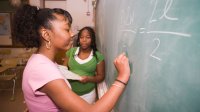Using a Writing Strategy to Help Middle School Students Solve Complex Word Problems
The claim-evidence-reasoning method promotes critical thinking by giving students a framework for solving multistep problems.
Before the start of the school year, my instructional leadership team meets to review several data sets thoroughly. We then discuss practices that all teachers should implement during classroom instruction. One of our required practices this past school year was teaching students how to utilize the claim-evidence-reasoning (CER) framework in all content areas and grade levels. CER is a writing strategy that promotes analytical thinking.
Our math instructional lead teacher, Mrs. Crusoe, saw this as an opportunity to have all math teachers participate in a professional development (PD) session focused on using CER when teaching students how to solve rigorous, multistep math problems. Ultimately, we wanted to ensure that all math teachers thoroughly understood each CER component because we believe that yields mathematically proficient students.
From my experience, educators tend to use the SOLVE or CUBES strategy for problem-solving. These methods are good mnemonics; however, the CER model has several benefits beyond assisting a student’s memory.
The CER model is particularly helpful when students are solving multistep math problems that require them to explain each step meticulously. The math PD session that my school facilitated to build teacher capacity focused on teaching students how to apply each part of CER and the eight standards for mathematical practice.
Twelve math teachers worked independently to align each component of CER with the standards and wrote a short report explaining their alignment. Then the math leaders met to develop an agreed-upon alignment to implement when teaching students how to use CER.
When creating the framework, we were intentional about using math vocabulary that the students were expected to know, as well as asking the students questions that would guide their critical thinking and assist them in leveraging the standards.
Collectively, the math department agreed that it was vital for the framework to counter students’ desire to opt out of doing word problems, write the infamous acronym IDK (“I don’t know”) when answering word problems, or rush through them and come up with an illogical answer.
Claim
For the claim component, we wanted students to unlock the prompt (word problem) by applying the three-reads literacy strategy to read for context, read to understand the quantities and their relationships, and read to understand what mathematical questions can be answered.
When students apply this strategy, they can state their final answer, answer the question thoroughly, be precise, and communicate a claim that makes sense mathematically. When identifying the claim, students are strongly encouraged to employ Mathematical Practice 1: Make sense of problems and persevere in solving them, and Mathematical Practice 6: Attend to precision.
Evidence
For the evidence component, we intentionally got students into the habit of showing their work in a method that best suited their problem-solving. Students may use words, numbers, graphs, symbols, data tables, or drawings when communicating their problem-solving.
When supporting their claim, students are encouraged to employ Mathematical Practice 2: Reason abstractly and quantitatively, Mathematical Practice 4: Model with mathematics, and Mathematical Practice 5: Use appropriate tools strategically.
Reasoning
For the reasoning component, we wanted students to justify their problem-solving method by explicitly communicating how the information given in the problem helped them decide upon a strategy to employ, the math skill(s) they learned that helped solve the problem, and the concepts they built on to solve the problem.
When conveying reasoning, students are encouraged to employ Mathematical Practice 3: Construct viable arguments and critique the reasoning of others, Mathematical Practice 7: Look for and make use of structure, and Mathematical Practice 8: Look for and express regularity in repeated reasoning.
Our CER framework can be implemented as is or tweaked based on your staff’s input and student needs. The critical thing to remember is that students will not master this skill overnight. Teachers will experience better student success if they allocate time daily to model the CER process when solving multi-step word problems.
To ensure that the process is student-led, it is strongly recommended that teachers allow students to use CER when working independently, in groups, and as a whole class. Ultimately, the end goal is for students to understand the CER framework so that they can apply it in real-world situations.
CER MONITORING
In addition to utilizing collaborative planning to facilitate PD on effective CER implementation, my math team monitors student CER work samples every quarter via a rubric. We engage in weekly discourse about pedagogical practices and student misconceptions about problem-solving.
The admin team continuously assesses student and teacher CER implementation through quarterly learning walks. Learning walk data is shared within 72 hours, and each teacher is afforded individualized feedback and action steps to implement.
As we close out this school year, my math department recognizes that we still have a lot of work to do. However, we are celebrating the fact that we have seen student gains in benchmark assessment scores, CER work samples, and student attitudes toward math. Going into the next school year, we expect even greater gains.
Sabrina Crusoe, Sayema Tareq, Adrienne Westlake, and Michelle Richardson contributed to this article.
